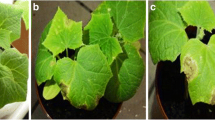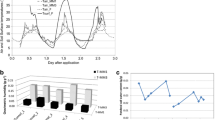Abstract
Wind tunnel studies and a field study were conducted to investigate the impact of the airborne herbicide bromoxynil-octanoate on non-target plants. Sunflowers at the two-leaf stage were used as test plants and exposed for 24 h in a wind tunnel to a range of concentrations of airborne bromoxynil-octanoate. Quantum yield of electron transport at Photosystem II (φPSII) of exposed leaves and leaves developed after exposure, plant height, days to flower and head diameter were used to determine the short- and long-term response of sunflowers to bromoxynil-octanoate. Quantum yield of exposed leaves and of the second leaf pair, determined 1 h and 2 days after exposure, was reduced at concentrations >0.449 and >1.159 μg/m3, respectively, but no effects on further leaf pairs developed after exposure were observed. Growth parameters were partly affected when exposed to >1.448 μg/m3. In a field study a maize plot was treated with bromoxynil-octanoate and parathion-methyl, used as a tracer compound. Afterwards, potted sunflowers were placed inside the maize plot and at different distances (2, 4, 8 and 16 m) from the treated plot. The highest concentrations of bromoxynil-octanoate and parathion-methyl collected in air samples at a distance of 8 m outside of the treated plot were 0.100 and 0.055 μg/m3, respectively. Little of the breakdown product bromoxynil phenol was detected in the air. Detectable concentrations of bromoxynil-octanoate and bromoxynil phenol were found only in a few leaf samples, whereas parathion-methyl was detected in almost 50% of the leaf samples up to 16 m from the treated plot. Quantum yield and growth of sunflower were not affected due to low concentrations of bromoxynil-octanoate in the air.


Similar content being viewed by others
References
Baker, L. Fritzell, D., Seiber, J., Parker, T., Shibamoto, T., Poore, M., Longley, K., Propper, R. and Duncan, D. (1996). Ambient air concentrations of pesticides in California Environ. Sci. Technol. 30, 1365–8
Behrens, R. and Leuschen, W.E. (1979). Dicamba volatility. Weed Sci. 27, 486–93
Eagle, D.J., (1982). Hazards to adjoining crops from vapor drift of phenoxy herbicides applied to cereals. Aspects Appl. Biol. 1, 33–41
Elliott, J.G. and Wilson, B.J. (1983). The influence of weather on the efficiency and safety of pesticide application: the drift of herbicides. BCPC Occasional Publication No. 3
Farewell, S.O., Robinson, E., Powell, W.J., and Adams, D.F. 1976. Survey of airborne 2,4-D in south-central Washington. J. Air Poll. Control Assoc. 26, 224–30
Follak, S. and Hurle, K. (2003a). Effect of airborne bromoxynil-octanoate and metribuzin on non-target plants. Environ. Poll. 126, 139–46
Follak, S. and Hurle, K. (2003b). Effect of airborne bromoxynil-octanoate on non-target plants under controlled and field conditions. Meeting Weed Sci. Soc. Am. 43, 35
Franzaring, J., Kempenaar, C. and van der Erden, L.J.M. (2001). Effects of vapours of chlorpropham and ethofumesate on wild plants species. Environ. Poll. 114, 21–8
Ganzelmaier, H. and Rautmann, D. (2000). Drift, drift reducing sprayers and sprayer testing. Aspects Appl. Biol. 57, 1–8
Genty, B., Briantais, J.-M. and Baker, N.R., (1989). The relationship between quantum yield of photosynthetic electron transport and quenching of chlorophyll fluorescence Biochim. Biophys. Acta 990, 87–92
Gilbey, D.J., Ralph, C.M., Scozz, A.N., Ebell, G.F. and Horne, R.W. (1984). Airborne 2,4-D and tomato damage at Geraldton, Western Australia. Aust. Weeds 3, 57–69
Hunt, R. (1982). Plant Growth Curves. UK: Edward Arnold
Marrs, R.H. and Frost, A.J. (1997). Microcosm approach for the detection of the effects of spray drift in plant communities. J. Environ. Manage. 50, 369–88
Niehaus, R., Scheulen, B. and Dürbeck, H.W. (1990). Determination of airborne polycyclic aromatic hydrocarbons using a filter/adsorber combination. Sci. Total Environ. 99, 163–72
Poster, J. (1986). Command herbicide. The rookie battles controversy. Crops Soils Mag. 39, 9–11
Richards, F.J. (1959). A flexible growth function for empirical use. J. Exp. Bot. 10, 290–300
Sanders, G.E. and Pallet, K.E. (1987). Studies into the differential activity of the hydroxybenzonitrile herbicides, II. Uptake, movement and metabolism in two contrasting species. Pestic. Biochem. Phys. 28, 163–71
Sandmann, E.R.I.C., de Beer, P.R. and van Dyk, L.P. (1991). Atmospheric pollution by auxin-type herbicides in Tala Valley, Natal. Chemosphere 22, 137–45
Schafer, D.E. and Chilcote, D.O. (1970). Translocation and degradation of bromoxynil in a resistant and a susceptible species. Weed Sci. 18, 729–32
Schweizer, A. and Hurle, K. (1999). Investigations on possible side effects of airborne pesticides on plants using chlorophyll fluorescence. Med. Fac. Landbouww. Uni. Gent. 64, 845–52
Seefeldt, S.S. Jensen, J.E. and Fuerst, E.P. (1995). Log-logistic analysis of herbicide dose–response relationships. Weed Technol. 9, 218–27
Smith, A.E. (1980). An analytical procedure for bromoxynil and its octanoate in soils; persistence studies with bromoxynil-octanoate in combination with other herbicides in soils. Pestic. Sci. 11, 341–46
Tahir, M.H.N., Sadagt, H.A. and Sajid, B. (2002). Correlation and path coefficient of morphological traits in sunflower (Helianthus annuus L.). Int. J. Agr. Biol. 4,341–343
Wall, D.A. (1997). Effect of crop growth stage on tolerance to low doses of thifensulfuron:tribenuron. Weed Sci. 45, 538–45
Wauchope, R.D., Buttler, T.M., Hornsby, A.G., Augustijn-Beckers, P.W.M. and Burt, J.P. (1992). The SCS/ARS/CES pesticide properties database for environmental decision-makingRev. Environ. Contam. Toxicol. 123, 1–157
Wittich, K.P. and Siebers, J. (2002). Aerial short-range dispersion of volatilised pesticides from an area source. Int. J. Biometeorol. 46, 126–35
Acknowledgment
Funding for this study was provided by the Deutsche Forschungsgemeinschaft (DFG). The study was carried out within the scope of the research project “Strategies to Reduce the Emission of Greenhouse Gases and Environmental Toxic Agents from Agriculture and Land use” at the University of Hohenheim, Germany.
Author information
Authors and Affiliations
Corresponding author
Rights and permissions
About this article
Cite this article
Follak, S., Walker, F. & Hurle, K. Short- and Long-Term Response of Sunflower to Airborne Bromoxynil-Octanoate Under Controlled and Field Conditions. Ecotoxicology 14, 503–512 (2005). https://doi.org/10.1007/s10646-005-0007-7
Accepted:
Published:
Issue Date:
DOI: https://doi.org/10.1007/s10646-005-0007-7




